| |
Racial Disparities in New HIV Diagnosis...HCV too
|
| |
| |
Download the PDF here
----------
from Jules: I would say the same disparity applies in HCV - that African-Americans are very much disproportionately affect, but this reflects health disparities overall in the USA. Healthcare access & success depends on health literacy & access to healthcare, and poverty & education. IDU drives HCV in the USA and if we are to eliminate HCV we must devise a strategy to provide HCV care & treatment for the IDU community. Understandably we need a program of services to support HCV care & treatment for IDUs. As well people in poverty & those marginalized patient groups from healthcare are less likely to receive HCV care & treatment. The restrictions imposed by Medicaids across the USA & supported implicitly by the Federal government as they have not taken strong action to prevent or begin to address this in a significant way - these restrictions target these disadvantaged communities the most - they are the communities who most utilize medicaid, with the least healthcare literacy & the most marginalized from the healthcare system. Eliminating HCV requires a program to address this: this means HCV screening programs, linkage-to-care programs, and adequate care and treatment. We have had new highly successful HCV treatments with 95% cure rates with only 12 weeks therapy for 2 years now but we are making very little progress in removing medicaid restrictions, and the Federal government has done little to prevent the state medicaid officials from imposing these restrictions. the Federal CMS agency sent a letter to state medicaid's about the restrictions but this letter had no teeth, states did not have to abide by the suggestion in the letter that the restrictions should be eliminated. It is only by lawsuits that there have been some changes in several states but these changes are overall not very significant. For example in Delaware a lawsuit was brought, the state entered into an agreement with the group bringing the lawsuit that apparently allows the state to delay changes 1-2 years. In Washington state a lawsuit appears to have removed restrictions. In Florida a lawsuit appears to improved the situation. What about all the other states. The federal government & The White House have done essentially nothing to remove these problems. The situation in NYS has changed not due to state officials but because Merck has provided a significant discount to several of the largest medicaid MCOs in NYS. NYS officials have not initiated any large scale screening & linkage to care programs nor have they taken any real actions to address access to care & treatment for the large numbers of marginalized patient populations.
---------------------------
reported at CROI 2016 - Half of black gay men and a quarter of Latino gay men projected to be diagnosed within their lifetime
If current HIV diagnoses rates persist, about 1 in 2 (50%) black men who have sex with men (MSM) and 1 in 4 (25%) Latino MSM in the United States will be diagnosed with HIV during their lifetime vs"1 in 11"(9-10%) for White MSM
At CROI Kristen Hess of the CDC reported in an oral talk that black MSM have the greatest lifetime risk for getting HIV - "1 in 2". But also Hispanoc MSM have "1 in 4" lifetime risk for contracting HIV, "1 in 11" for White MSM
Black female IDU had a "1 in 6" lifetime risk for contracting HIV.
SEE CROI CDC REPORT below following the SF DOH reporting
--------------------------------------------
San Francisco is working toward a bold goal: to reach zero new infections, zero AIDS-related deaths, and zero HIV stigma. New data, released today, show that the city is making significant progress toward its goals....http://betablog.org/getting-zero-san-francisco/
The San Francisco community has set a high bar by pledging tobe the first city in the United States to achieve "Getting to Zero: zero new HIV infections; zero HIV deaths;and zero HIV stigma."
The total # on new HIV infections in SF fell to 262 in 2015 down from 382 in 2013 & from 419 in 2011 and 531 in 2007.
"The number of new HIV diagnoses declined from 528 in 2006 to 255 in 2015. The number of deaths declined
from 327 in 2006 to 197 in 2015"
"While whites and Latinos in 2013 have a rate comparableto the overall statewide rate, between 11 and 13 recent infections per 100,000, the rate of recent infectionsamong African Americans is disproportionately high: 33 new infections per 100,000 African Americans in 2013.With caution given to the large margin of error, the data suggest higher incidence among African Americansand men between 2010 and 2013 compared to other races and women." page
30 https://www.sfdph.org/dph/files/reports/RptsHIVAIDS/AnnualReport2015-20160831.pdf
from SFAF: Although the total number of new infections declined last year, disparities between different racial and ethnic groups remain. African Americans are the only racial group in San Francisco that have not seen a decline in the number of new HIV infections-and African American men and Latino men had the highest HIV infection rates in the city. African Americans living with HIV had the lowest rates of viral suppression and highest mortality rates from HIV/AIDS. Asian and Pacific Islanders had the highest proportion of late stage (stage 3, AIDS) diagnoses. http://betablog.org/34-decrease-san-francisco-hiv-infections-2013-2015-racial-disparities-remain/
from Jules: although if you look at the actual data [see table 5 below] from the SF DOH the percents of all new HIV infections among African-Americans has essentially remained the same over the years while among Blacks you see little or no reduction. But in looking at the actual numbers of new infections that has declined for Blacks from 80 in 2005 to 65 in 2011 and to 44 in 2015.
SF DOH Reports this:
Trends by racial/ethnic category for persons newly diagnosed with HIV infection show that, from 2006through 2015, whites accounted for the majority of newly diagnosed cases (Figure 2.1- see below). The number of whiteHIV cases declined for most of this time period, leveled off between 2009 and 2012, and then continued todecline through 2015. The number of African American cases declined from 76 cases in 2006 to 33 cases in2014 but then increased to 43 cases in 2015. Annual number of diagnoses in Asian/Pacific Islanders is similarto African Americans from 2012 and onward. The number of Latino HIV cases declined from 119 cases in2008 to 67 cases in 2015.
Of note those diagnosis with HIV at late stage disease (stage 3 - AIDS) - overall these numbers have declined to 122 in 2015 from 250 in 2011. Regarding the percent ethnically of these 122 & the historical trend - the % of these 122 was 15.6% for Blacks which declined very little - it was 17.6%in 2011 7 15.8% in 2012, while for Latinos the percent has increased from 18.4% in 2011 to 26.2% in 2015; for whites the % was 52.4% in 2011 & declined to 46.7% in 2015.
Of note new infections for men were mostly from sex with gay or bisexual men - but for women both White & Black 90% of new HIV infections were through IDU & heterosexual transmission.
SF DOH Epidemiology Report 6/30/2015 semi-annual report
https://www.sfdph.org/dph/files/reports/RptsHIVAIDS/SemiAnnualReportJune-2016.pdf
As you can see in Figure 1 more people are ling with HIV while new diagnoses have plummeted.

The number of new HIV infections diagnosed in San Francisco hit an all-time low in 2015, with a total of 255 infections, according to the 2015 HIV Epidemiology Annual Report published today by the San Francisco Department of Public Health. According to the most recent HIV Semi-Annual Surveillance report, with data through the first half of 2016, there have been a total of 99 infections diagnosed so far this year.
The number of people diagnosed in 2015 shows a 17% decrease from the number of people diagnosed in 2014, when there were 308 infections. It is also a 34% decrease from 2013, when there were 385 infections, and a 44% decrease from 2012, when there were 454 infections. In 2015, 79% of all new HIV infections in men were among men who have sex with men.

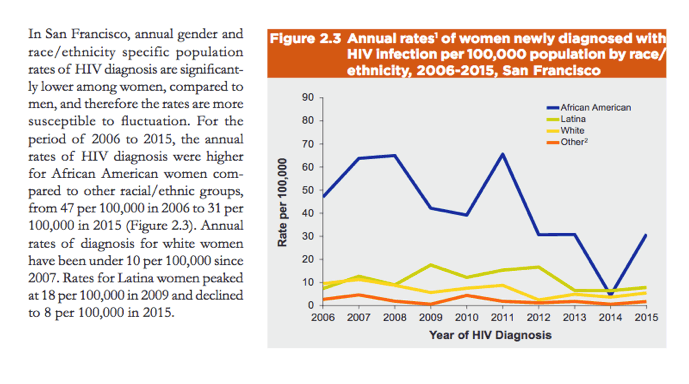
African Americans are the only racial group in San Francisco that have not seen a decline in the number of new HIV infections-and African American men and Latino men had the highest HIV infection rates in the city. African Americans living with HIV had the lowest rates of viral suppression and highest mortality rates from HIV/AIDS. Asian and Pacific Islanders had the highest proportion of late stage (stage 3, AIDS) diagnoses.....http://betablog.org/34-decrease-san-francisco-hiv-infections-2013-2015-racial-disparities-remain/
--------------
SF DOH Report - Trends in HIV Diagnoses
Race/ethnicity
Trends by racial/ethnic category for persons newly diagnosed with HIV infection show that, from 2006through 2015, whites accounted for the majority of newly diagnosed cases (Figure 2.1). The number of whiteHIV cases declined for most of this time period, leveled off between 2009 and 2012, and then continued todecline through 2015. The number of African American cases declined from 76 cases in 2006 to 33 cases in2014 but then increased to 43 cases in 2015. Annual number of diagnoses in Asian/Pacific Islanders is similarto African Americans from 2012 and onward. The number of Latino HIV cases declined from 119 cases in2008 to 67 cases in 2015.
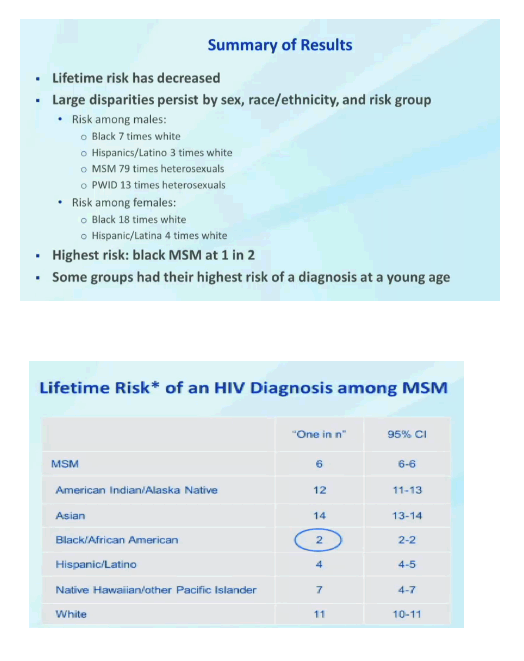
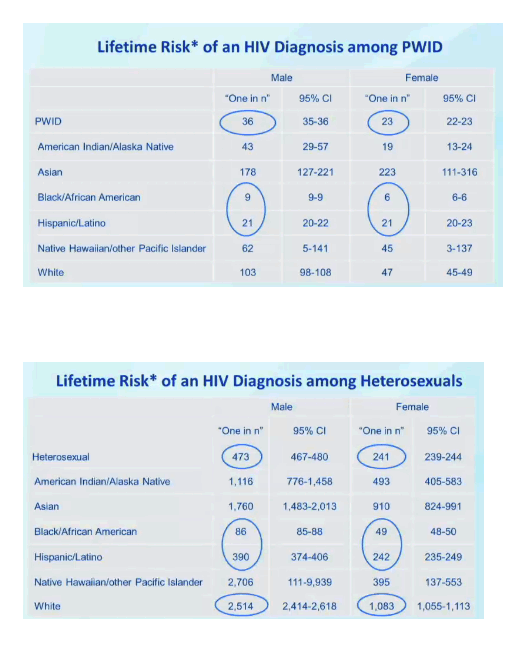
-----------------------
Half of black gay men and a quarter of Latino gay men projected to be diagnosed within their lifetime
If current HIV diagnoses rates persist, about 1 in 2 black men who have sex with men (MSM) and 1 in 4 Latino MSM in the United States will be diagnosed with HIV during their lifetime
At CROI Kristen Hess of the CDC reported in an oral talk that black MSM have the greatest lifetime risk for getting HIV - "1 in 2". But also Hispanoc MSM have "1 in 4" lifetime risk for contracting HIV, "1 in 11" for White MSM
Black female IDU had a "1 in 6" lifetime risk for contracting HIV.
Black female heterosexuals had the highest risk among Heterosexuals "1 in 49", which was almost twice the 2nd highest risk group Black me whose risk was "1 in 86".
Washington DC area had the highest risk "i in 13" of any other geographic area in the US, the overall risk was "1 in 99" for the entire USA. Of the states the highest lifetime risk was in the South (see slide below). NY was pretty high too.
CDC:
⋅ Gay and bisexual men continue to be most affected by the HIV epidemic in the U.S. At current rates, 1 in 6 MSM will be diagnosed with HIV in their lifetime, including 1 in 2 black MSM, 1 in 4 Latino MSM, and 1 in 11 white MSM.
⋅ African Americans are by far the most affected racial or ethnic group with a lifetime HIV risk of 1 in 20 for men (compared to 1 in 132 for whites) and 1 in 48 for women (compared to 1 in 880 for whites).
⋅ People who inject drugs are at much higher lifetime risk than the general population, and women who inject drugs have a higher risk than men (1 in 23 compared with 1 in 36).
⋅ People living in the South are more likely to be diagnosed with HIV over the course of their lifetime than other Americans, with the highest risk in Washington, DC (1 in 13), Maryland (1 in 49), Georgia (1 in 51), Florida (1 in 54), and Louisiana (1 in 56).
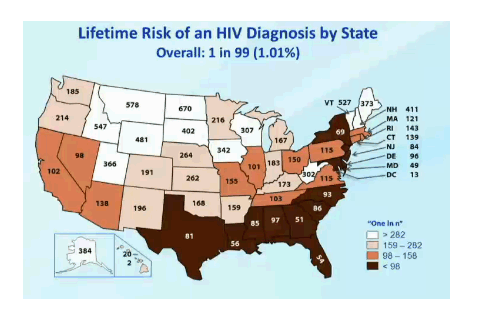
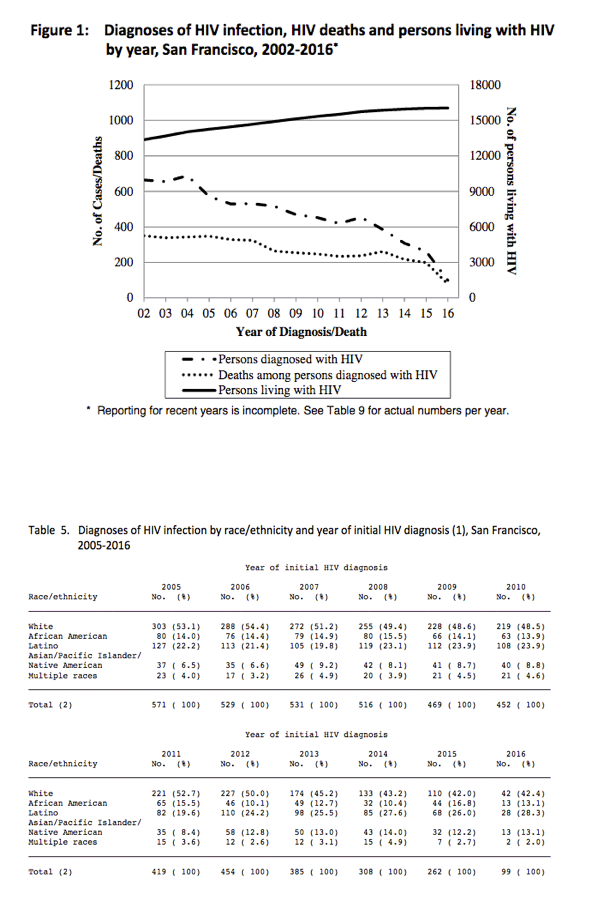
http://www.croiwebcasts.org/console/player/29467?mediaType=slideVideo&
Half of black gay men and a quarter of Latino gay men projected to be diagnosed within their lifetime
If current HIV diagnoses rates persist, about 1 in 2 black men who have sex with men (MSM) and 1 in 4 Latino MSM in the United States will be diagnosed with HIV during their lifetime, according to a new analysis by researchers at the Centers for Disease Control and Prevention (CDC). The study, presented today at the Conference on Retroviruses and Opportunistic Infections in Boston, provides the first-ever comprehensive national estimates of the lifetime risk of an HIV diagnosis for several key populations at risk and in every state.
"As alarming as these lifetime risk estimates are, they are not a foregone conclusion. They are a call to action," said Jonathan Mermin, M.D., director of CDC's National Center for HIV/AIDS, Viral Hepatitis, STD, and Tuberculosis Prevention. "The prevention and care strategies we have at our disposal today provide a promising outlook for future reductions of HIV infections and disparities in the U.S., but hundreds of thousands of people will be diagnosed in their lifetime if we don't scale up efforts now."
CDC researchers used diagnoses and death rates from 2009-2013 to project the lifetime risk of HIV diagnosis in the United States by sex, race and ethnicity, state, and HIV risk group, assuming diagnoses rates remain constant. Overall, the lifetime risk of HIV diagnosis in the U.S. is now 1 in 99, an improvement from a previous analysis using 2004-2005 data that reported overall risk at 1 in 78.
However, this overall progress masks large disparities:
⋅ Gay and bisexual men continue to be most affected by the HIV epidemic in the U.S. At current rates, 1 in 6 MSM will be diagnosed with HIV in their lifetime, including 1 in 2 black MSM, 1 in 4 Latino MSM, and 1 in 11 white MSM.
⋅ African Americans are by far the most affected racial or ethnic group with a lifetime HIV risk of 1 in 20 for men (compared to 1 in 132 for whites) and 1 in 48 for women (compared to 1 in 880 for whites).
⋅ People who inject drugs are at much higher lifetime risk than the general population, and women who inject drugs have a higher risk than men (1 in 23 compared with 1 in 36).
⋅ People living in the South are more likely to be diagnosed with HIV over the course of their lifetime than other Americans, with the highest risk in Washington, DC (1 in 13), Maryland (1 in 49), Georgia (1 in 51), Florida (1 in 54), and Louisiana (1 in 56).
"These estimates are a sobering reminder that gay and bisexual men face an unacceptably high risk for HIV - and of the urgent need for action," said Eugene McCray, M.D., director of CDC's Division of HIV/AIDS Prevention. "If we work to ensure that every American has access to the prevention tools we know work, we can avoid the outcomes projected in this study."
CDC's High Impact Prevention approach focuses on delivering the most effective prevention strategies - including HIV testing, ongoing care and treatment for people living with HIV, pre-exposure prophylaxis (PrEP, a daily anti-HIV pill for high-risk uninfected people) and condoms - to the populations that are most heavily affected by the epidemic. CDC devotes more HIV prevention resources to MSM, especially MSM of color, than to any other risk group. And since 2010, CDC has greatly increased HIV prevention funding to Southern health departments and community-based organizations, to reflect the burden of HIV in the region.
|
|
| |
| |
|
|
|